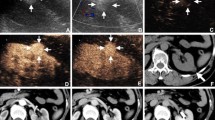Abstract
Objective
To compare the diagnostic efficiency of contrast-enhanced ultrasound (CEUS) with that of dynamic contrast-enhanced magnetic resonance imaging (DCE-MRI) for the differential diagnosis of clear and non-clear cell renal cell carcinoma, as confirmed by subsequent pathology.
Methods
A total of 181 patients with 184 renal lesions diagnosed by both CEUS and DCE-MRI were enrolled in the study, including 136 clear cell renal cell carcinoma (ccRCC) and 48 non-clear cell renal cell carcinoma (non-ccRCC) tumors. All lesions were confirmed by histopathologic diagnosis after surgical resection. Interobserver agreement was estimated using a weighted kappa statistic. Diagnostic efficiency in evaluating ccRCC and non-ccRCC was compared between CEUS and DCE-MRI.
Results
The weighted kappa value for interobserver agreement was 0.746 to 0.884 for CEUS diagnosis and 0.764 to 0.895 for DCE-MRI diagnosis. Good diagnostic performance in differential diagnosis of ccRCC and non-ccRCC was displayed by both CEUS and DCE-MRI: sensitivity was 89.7% and 91.9%, respectively; specificity was 77.1% and 68.8%, respectively; and area under the receiver operating curve was 0.834 and 0.803, respectively. No statistically significant differences were present between the two methods (p = 0.54).
Conclusions
Both CEUS and DCE-MRI imaging are effective for the differential diagnosis of ccRCC and non-ccRCC. Thus, CEUS could be an alternative to DCE-MRI as a first test for patients at risk of renal cancer, particularly where DCE-MRI cannot be carried out.
Key Points
• CEUS and DCE-MRI features can help differentiate ccRCC and non-ccRCC.
• The differential diagnosis of ccRCC and non-ccRCC by CEUS is comparable to that of DCE-MRI.
• Interobserver agreement is generally high using CEUS and DCE-MRI.




Similar content being viewed by others
Abbreviations
- ccRCC :
-
Clear cell renal cell carcinoma
- CEUS :
-
Contrast-enhanced ultrasound
- chRCC:
-
Chromophobe renal cell carcinoma
- DCE-MRI:
-
Dynamic contrast-enhanced magnetic resonance imaging
- MI:
-
Mechanical index
- non-ccRCC :
-
Non-clear cell renal cell carcinoma
- NPV:
-
Negative predictive value
- PPV :
-
Positive predictive value
- pRCC :
-
Papillary renal cell carcinoma
- RCC:
-
Renal cell carcinoma
- ROC :
-
Receiver operating characteristic
References
Campbell SC, Clark PE, Chang SS, Karam JA, Souter L, Uzzo RG (2021) Renal mass and localized renal cancer: evaluation, management, and follow-up: AUA Guideline: Part I. J Urol 206:199–208
Lightfoot N, Conlon M, Kreiger N et al (2000) Impact of noninvasive imaging on increased incidental detection of renal cell carcinoma. Eur Urol 37:521–527
Siegel RL, Miller KD, Jemal A (2018) Cancer statistics, 2018. CA Cancer J Clin 68:7–30
Ljungberg B, Albiges L, Abu-Ghanem Y et al (2019) European Association of Urology Guidelines on Renal Cell Carcinoma: the 2019 update. Eur Urol 75:799–810
Moch H, Cubilla AL, Humphrey PA, Reuter VE, Ulbright TM (2016) The 2016 WHO Classification of Tumours of the Urinary System and Male Genital Organs-Part A: renal, penile, and testicular tumours. Eur Urol 70:93–105
Steffens S, Roos FC, Janssen M et al (2014) Clinical behavior of chromophobe renal cell carcinoma is less aggressive than that of clear cell renal cell carcinoma, independent of Fuhrman grade or tumor size. Virchows Arch 465:439–444
Ficarra V, Martignoni G, Galfano A et al (2006) Prognostic role of the histologic subtypes of renal cell carcinoma after slide revision. Eur Urol 50:786–793; discussion 793–784
Patel HD, Johnson MH, Pierorazio PM et al (2016) Diagnostic accuracy and risks of biopsy in the diagnosis of a renal mass suspicious for localized renal cell carcinoma: systematic review of the literature. J Urol 195:1340–1347
Finelli A, Ismaila N, Bro B et al (2017) Management of small renal masses: american society of clinical oncology clinical practice guideline. J Clin Oncol 35:668–680
Bertolotto M, Bucci S, Valentino M, Curro F, Sachs C, Cova MA (2018) Contrast-enhanced ultrasound for characterizing renal masses. Eur J Radiol 105:41–48
Nikken JJ, Krestin GP (2007) MRI of the kidney-state of the art. Eur Radiol 17:2780–2793
Oliva MR, Glickman JN, Zou KH et al (2009) Renal cell carcinoma: t1 and t2 signal intensity characteristics of papillary and clear cell types correlated with pathology. AJR Am J Roentgenol 192:1524–1530
Kim JH, Bae JH, Lee KW, Kim ME, Park SJ, Park JY (2012) Predicting the histology of small renal masses using preoperative dynamic contrast-enhanced magnetic resonance imaging. Urology 80:872–876
Young JR, Coy H, Kim HJ et al (2017) Performance of relative enhancement on multiphasic MRI for the differentiation of clear cell renal cell carcinoma (RCC) from papillary and chromophobe RCC subtypes and oncocytoma. AJR Am J Roentgenol 208:812–819
Pedrosa I, Chou MT, Ngo L et al (2008) MR classification of renal masses with pathologic correlation. Eur Radiol 18:365–375
Sun MR, Ngo L, Genega EM et al (2009) Renal cell carcinoma: dynamic contrast-enhanced MR imaging for differentiation of tumor subtypes–correlation with pathologic findings. Radiology 250:793–802
Gerst S, Hann LE, Li D et al (2011) Evaluation of renal masses with contrast-enhanced ultrasound: initial experience. AJR Am J Roentgenol 197:897–906
Cai Y, Du L, Li F, Gu J, Bai M (2014) Quantification of enhancement of renal parenchymal masses with contrast-enhanced ultrasound. Ultrasound Med Biol 40:1387–1393
Rubenthaler J, Paprottka K, Marcon J et al (2016) Comparison of magnetic resonance imaging (MRI) and contrast-enhanced ultrasound (CEUS) in the evaluation of unclear solid renal lesions. Clin Hemorheol Microcirc 64:757–763
Defortescu G, Cornu JN, Bejar S et al (2017) Diagnostic performance of contrast-enhanced ultrasonography and magnetic resonance imaging for the assessment of complex renal cysts: a prospective study. Int J Urol 24:184–189
Xue LY, Lu Q, Huang BJ et al (2015) Papillary renal cell carcinoma and clear cell renal cell carcinoma: differentiation of distinct histological types with contrast - enhanced ultrasonography. Eur J Radiol 84:1849–1856
Jiang J, Chen Y, Zhou Y, Zhang H (2010) Clear cell renal cell carcinoma: contrast-enhanced ultrasound features relation to tumor size. Eur J Radiol 73:162–167
Ascenti G, Gaeta M, Magno C et al (2004) Contrast-enhanced second-harmonic sonography in the detection of pseudocapsule in renal cell carcinoma. AJR Am J Roentgenol 182:1525–1530
Zhang J, Lefkowitz RA, Ishill NM et al (2007) Solid renal cortical tumors: differentiation with CT. Radiology 244:494–504
Xue LY, Lu Q, Huang BJ, Li CX, Yan LX, Wang WP (2016) Differentiation of subtypes of renal cell carcinoma with contrast-enhanced ultrasonography. Clin Hemorheol Microcirc 63:361–371
Li CX, Lu Q, Huang BJ et al (2016) Quantitative evaluation of contrast-enhanced ultrasound for differentiation of renal cell carcinoma subtypes and angiomyolipoma. Eur J Radiol 85:795–802
Aggarwal A, Goswami S, Das CJ (2022) Contrast-enhanced ultrasound of the kidneys: principles and potential applications. Abdom Radiol (NY) 47:1369–1384
Liu Y, Kan Y, Zhang J, Li N, Wang Y (2021) Characteristics of contrast-enhanced ultrasound for diagnosis of solid clear cell renal cell carcinomas </=4 cm: A meta-analysis. Cancer Med 10:8288–8299
Gulati M, King KG, Gill IS, Pham V, Grant E, Duddalwar VA (2015) Contrast-enhanced ultrasound (CEUS) of cystic and solid renal lesions: a review. Abdom Imaging 40:1982–1996
Beksac AT, Paulucci DJ, Blum KA, Yadav SS, Sfakianos JP, Badani KK (2017) Heterogeneity in renal cell carcinoma. Urol Oncol 35:507–515
Leveridge MJ, Bostrom PJ, Koulouris G, Finelli A, Lawrentschuk N (2010) Imaging renal cell carcinoma with ultrasonography, CT and MRI. Nat Rev Urol 7:311–325
Schieda N, van der Pol CB, Walker D et al (2020) Adverse events to the gadolinium-based contrast agent gadoxetic acid: systematic review and meta-analysis. Radiology 297:565–572
Serter A, Onur MR, Coban G, Yildiz P, Armagan A, Kocakoc E (2021) The role of diffusion-weighted MRI and contrast-enhanced MRI for differentiation between solid renal masses and renal cell carcinoma subtypes. Abdom Radiol (NY) 46:1041–1052
Stock KF, Slotta-Huspenina J, Kubler H, Autenrieth M (2019) Innovative ultrasound-based diagnosis of renal tumors. Urologe A 58:1418–1428
Acknowledgements
The authors thank the pathologist (C.C.) for reviewing all of the specimens and evaluating histopathology.
Funding
The authors state that this work has not received any funding.
Author information
Authors and Affiliations
Corresponding authors
Ethics declarations
Guarantor
The scientific guarantor of this publication is Qiuyang Li.
Conflict of interest
The authors of this manuscript declare no relationships with any companies whose products or services may be related to the subject matter of the article.
Statistics and biometry
No complex statistical methods were necessary for this paper.
Informed consent
Written informed consent was not required for this study because this study was a retrospective analysis and did not involve private patient information, informed consent was not required.
Ethical approval
Institutional Review Board approval was obtained.
Methodology
• retrospective
• diagnostic study
• performed at one institution
Additional information
Publisher's note
Springer Nature remains neutral with regard to jurisdictional claims in published maps and institutional affiliations.
Rights and permissions
Springer Nature or its licensor (e.g. a society or other partner) holds exclusive rights to this article under a publishing agreement with the author(s) or other rightsholder(s); author self-archiving of the accepted manuscript version of this article is solely governed by the terms of such publishing agreement and applicable law.
About this article
Cite this article
Zhao, P., Zhu, J., Wang, L. et al. Comparative diagnostic performance of contrast-enhanced ultrasound and dynamic contrast-enhanced magnetic resonance imaging for differentiating clear cell and non-clear cell renal cell carcinoma. Eur Radiol 33, 3766–3774 (2023). https://doi.org/10.1007/s00330-023-09391-9
Received:
Revised:
Accepted:
Published:
Issue Date:
DOI: https://doi.org/10.1007/s00330-023-09391-9




